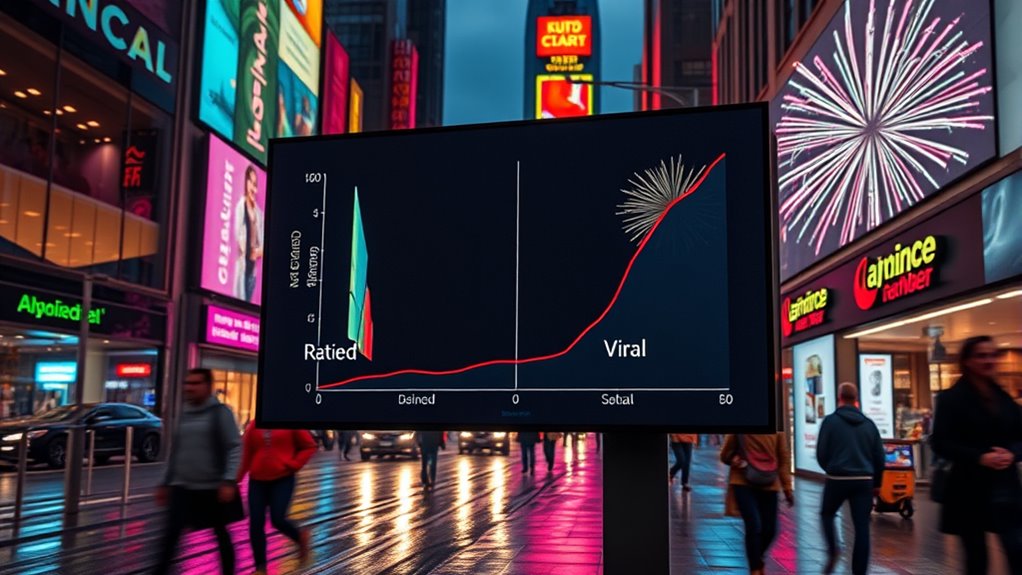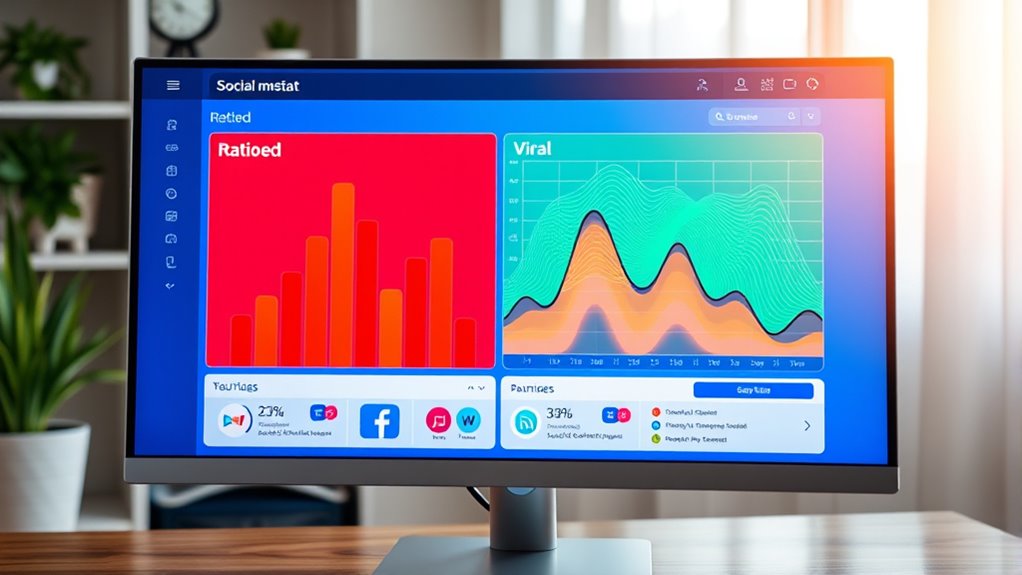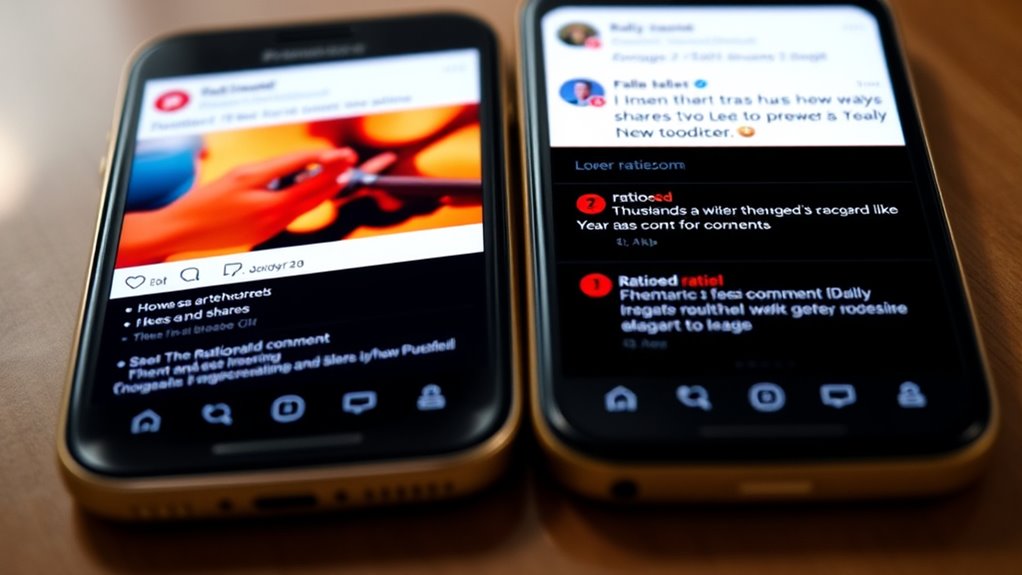Understanding “viral” versus “ratioed” helps you gauge social media impact. Viral content spreads rapidly, gains wide visibility, and often taps into current trends or emotions, boosting engagement. In contrast, being ratioed means receiving more replies or negative feedback than likes, signaling controversy or audience disagreement. Recognizing these metrics guides how you create or respond to posts—if you want to learn more about managing content success and controversy, keep going.
Key Takeaways
- “Viral” refers to content spreading rapidly and broadly, generating high engagement and visibility on social media.
- “Ratioed” indicates a post has more negative replies than likes or retweets, signaling disagreement or controversy.
- Viral content typically boosts followers and reach, while ratioed posts often highlight dissatisfaction or backlash.
- Metrics for virality focus on rapid spread and engagement levels; ratioing emphasizes audience sentiment and disagreement.
- Viral posts benefit creators, but ratioed posts can harm reputation and reflect controversy or poor reception.
Understanding the Concept of Going Viral

Have you ever wondered what makes a post go viral? It mainly comes down to content virality—when your content spreads rapidly across social media platforms. Viral posts often tap into meme culture, which helps them resonate quickly with audiences. Funny, relatable, or emotionally charged content tends to gain traction faster. When your message aligns with current trends or humor, it’s more likely to be shared widely. The key is creating content that sparks a reaction, whether laughter, surprise, or agreement. As you craft your posts, focus on elements that encourage sharing and engagement. Understanding relationships and personality traits can also help tailor content that appeals to your audience’s emotional needs. That’s how your content can hit that elusive viral status, making it a staple in meme culture and beyond.
What Does It Mean to Be Ratioed?

Ever wondered what it means to be ratioed on social media? When your post receives markedly more replies or quote tweets than likes or retweets, it’s considered ratioed. This signals a shift in audience perception—people often see it as a sign your message missed the mark or sparked controversy. Engagement psychology explains why being ratioed impacts your credibility; it suggests that viewers disagree or disapprove, shaping how others perceive your content. Instead of positive reinforcement, it creates a perception of backlash or disagreement. This can influence your reputation and future engagement, as people tend to base their opinions on the visible reactions. Additionally, understanding the cost factors involved in content creation or promotion can help you better interpret engagement metrics. Ultimately, being ratioed reveals a lot about how your audience interprets your message and their willingness to engage critically.
The Mechanics Behind Viral Content

Viral content spreads rapidly because it taps into shared emotions or timely trends that resonate with a broad audience. When your content connects emotionally—whether through humor, awe, anger, or empathy—it encourages viewers to engage and share. Timing also plays a pivotal role; posting about trending topics or current events increases the chance of content virality. Audience engagement is essential, as it signals relevance and encourages interaction, such as comments, shares, and likes. The more your audience interacts, the more algorithms promote your content, fueling its viral potential. Additionally, understanding the importance of content relevance can significantly boost the likelihood of your content going viral, as it ensures your message aligns with audience interests and current trends. Understanding these mechanics helps you craft content that not only captures attention but also prompts active participation, making it more likely to spread widely across social platforms.
How Ratioing Reflects Audience Sentiment

When a piece of content sparks strong emotional reactions, the way audiences respond often reveals their true sentiments. Ratioing serves as a real-time indicator of audience perception, showing whether people agree or disagree. By examining the ratio of likes, comments, and dislikes, you can gauge the sentiment analysis behind the post. A heavily ratioed post typically signals disagreement or controversy, reflecting negative audience sentiment. Conversely, a well-received post with more likes than dislikes suggests positive engagement. Keep an eye on these cues:
- High dislike-to-like ratio signals disapproval
- Numerous negative comments indicate dissatisfaction
- Limited engagement may imply ambivalence
- Contrasting reactions reveal polarized opinions
Understanding audience sentiment through these signals helps you grasp how your audience truly feels, beyond surface-level metrics.
Key Differences Between Viral and Ratioed Posts

You’ll notice that viral posts generate high engagement and broad reach, often spreading quickly across platforms. In contrast, ratioed posts tend to reveal audience disagreement or dissatisfaction, impacting their overall influence. Understanding these differences helps you gauge how each type of post shapes online conversations and impacts visibility. Additionally, the context of the content, such as a Volkswagen Tuning modification or community discussion, can influence whether a post becomes viral or ratioed.
Engagement Levels Explained
Understanding the engagement levels of posts is essential for distinguishing between viral and ratioed content. Engagement metrics reveal how audiences react and interact, highlighting the difference in content virality. Viral posts typically generate high engagement across multiple metrics, such as likes, shares, and comments, indicating widespread interest. In contrast, ratioed posts often have a high number of replies or quote tweets, showing disagreement or controversy. To grasp these differences better, consider:
- The ratio of likes to replies
- The number of shares versus comments
- Overall reach versus engagement intensity
- The nature of audience interactions (supportive or critical)
- The importance of content quality in influencing engagement levels
These insights help you interpret what each post’s engagement level says about its impact and reception, clarifying how virality and ratioing reflect different audience responses.
Impact and Reach Differences
Have you ever noticed how some posts rapidly spread across platforms while others spark heated debates? That’s the impact of content virality versus a ratioed post. Viral content gains massive audience reach quickly, often crossing social media boundaries and attracting diverse viewers. It’s designed to be shared widely, creating a ripple effect that amplifies its presence. In contrast, a ratioed post usually sparks controversy or disagreement, limiting its audience reach to those engaged or affected by the debate. While viral posts boost visibility and brand awareness, ratioed posts tend to focus conversations within niche groups or communities. Understanding these impact differences helps you gauge a post’s influence—whether you’re aiming for widespread content virality or engaging in targeted, impactful discussions.
Indicators That a Post Is Going Viral

When a post starts gaining rapid attention, certain clear signs indicate it’s going viral. You’ll notice social media algorithms pushing it to a broader audience quickly. Engagement spikes, with many likes, shares, and comments pouring in. The comment section becomes lively, showing active discussion. Additionally, your content’s reach expands beyond your usual followers, reaching new communities. You might also see trending tags or hashtags associated with your post. These are strong indicators of content virality, meaning your post resonates widely and spreads fast. Recognizing these signs helps you understand that your content is resonating with the audience, fueling its viral potential. Staying aware of visual appeal and how well your content fits current trends can further enhance its chances of going viral.
Signs That a Post Is Being Ratioed

While a post gaining widespread attention is exciting, not all signs are positive. If you notice your tweet or comment is being ratioed, it’s a clear sign it’s hitting a nerve. Usually, this involves many replies that criticize or mock your content, often highlighting clickbait tactics or shallow meme culture. A high number of negative responses compared to likes indicates your post is being ratioed. You might also see responses that call out the post’s dishonesty or absurdity, especially if it relies on sensationalism. Often, users will use memes or sarcastic remarks to express their disagreement. Recognizing these signs can help you understand if your content is resonating poorly or sparking controversy, rather than genuine engagement. Additionally, observing cyber threats or coordinated responses can signal underlying issues with security or trustworthiness.
The Impact of Viral Content on Social Media Presence

Viral content can considerably amplify your social media presence in a short amount of time. When your posts go viral, they reach a broader audience, increasing engagement and followers. However, this rapid growth can also challenge your content moderation efforts, as more comments and interactions require swift oversight. Algorithm changes often favor viral posts, boosting visibility and engagement, but they can also de-prioritize content that doesn’t perform well. To maximize benefits, you should:
- Stay updated on platform algorithm shifts
- Maintain active content moderation to manage comments
- Create shareable, authentic content
- Monitor analytics to understand what resonates
- Recognize the importance of emotional support in maintaining audience trust and loyalty
The Implications of Ratioing for Creators and Brands

Ratioing, where a post receives especially more negative comments or reactions than positive ones, can have serious implications for your influencer reputation and your brand’s credibility. When a post is ratioed, audiences may interpret it as a sign of controversy or misjudgment, damaging trust. For creators, this can lead to a decline in followers and partnerships, as brands become hesitant to associate with someone linked to negative sentiment. Similarly, brands risk being perceived as out of touch or insensitive, which can hurt their market position. Even if your content is well-intentioned, ratioing can overshadow your message, making it vital to monitor engagement carefully. Addressing ratioed posts promptly and authentically is key to minimizing long-term damage to reputation and credibility. Additionally, understanding the impact of public perception on brand reputation underscores the importance of managing engagement and responses effectively.
Strategies to Foster Positive Engagement and Avoid Ratioing

To foster positive engagement and steer clear of ratioing, you should focus on creating authentic, value-driven content that resonates with your audience. Use audience segmentation to tailor your messages, ensuring relevance and relatability. Prioritize effective content moderation to keep conversations respectful and constructive. Here are strategies to help you succeed:
Foster genuine engagement with authentic content, audience segmentation, and respectful moderation to create meaningful conversations.
- Analyze your audience segments to understand their preferences
- Respond thoughtfully to comments to build trust
- Use content moderation tools to filter negativity or spam
- Encourage open dialogue while setting clear community guidelines
- Incorporate anime movies into your content to connect with diverse interests and boost engagement.
Frequently Asked Questions
Can a Post Be Both Viral and Ratioed Simultaneously?
Yes, a post can be both viral and ratioed at the same time. When a post gains rapid attention, it becomes viral, but if it also receives a high number of negative responses or criticisms, it can be ratioed. This often raises engagement manipulation or authenticity concerns, as people question whether the viral spread is genuine or driven by controversy. You should consider these metrics carefully to assess true engagement and credibility.
How Do Algorithms Influence Viral Versus Ratioed Content?
Algorithms heavily influence viral and ratioed content by prioritizing engagement metrics like likes, shares, and comments. You can manipulate algorithms through engagement inflation, encouraging more interaction to boost visibility. This often results in viral posts that spread quickly, but sometimes they might be ratioed, indicating mixed reactions. Understanding how algorithms favor high engagement helps you craft content that’s more likely to go viral without falling into the trap of engagement manipulation.
What Role Do Bots Play in Ratioing or Virality?
Bot manipulation often drives fake engagement, impacting whether content gets ratioed or goes viral. Bots can artificially inflate likes, comments, or shares, making a post seem more popular or controversial than it truly is. This fake engagement skews perception, encouraging real users to engage more or less, depending on the tactics. Ultimately, bots influence the metrics behind virality and ratioing, often distorting genuine audience reactions.
Do Different Social Media Platforms Have Varying Metrics for Ratios?
Yes, different social media platforms have varying metrics for ratios and engagement measurement. You’ll find platform-specific metrics like retweets on Twitter, likes and shares on Facebook, and views on TikTok. These differences shape how you interpret virality and ratioing. Understanding each platform’s unique engagement measurement helps you better gauge content performance, adjust your strategy, and recognize what resonates most with your audience across diverse social media channels.
How Can Creators Recover From a Ratioed Post?
Think of recovering from a ratioed post like steering a ship after a storm—you can do it with patience. To bounce back, engage openly with your audience, address concerns honestly, and provide valuable content. Focus on engagement recovery by responding thoughtfully and showing transparency. This approach helps with reputation management, demonstrating you’re committed to improvement and listening, ultimately restoring trust and positively shifting your social media presence.
Conclusion
Understanding the difference between viral and ratioed content helps you navigate social media better. Did you know that over 70% of users consider ratioed posts as negative feedback? This shows how essential it is to foster positive engagement. By paying attention to these metrics, you can improve your content’s reception and build a stronger online presence. Keep these insights in mind, and you’ll be better equipped to create posts that resonate and avoid unwanted ratioing.









